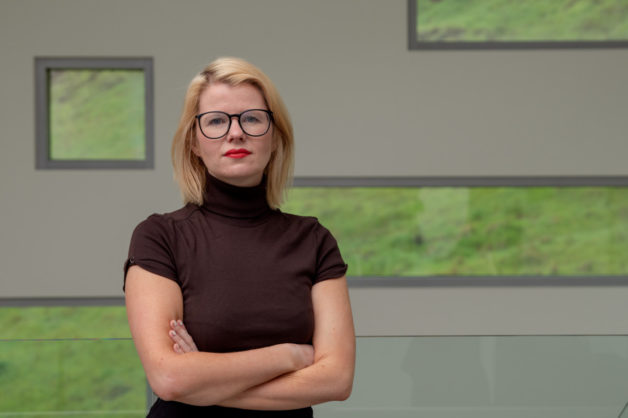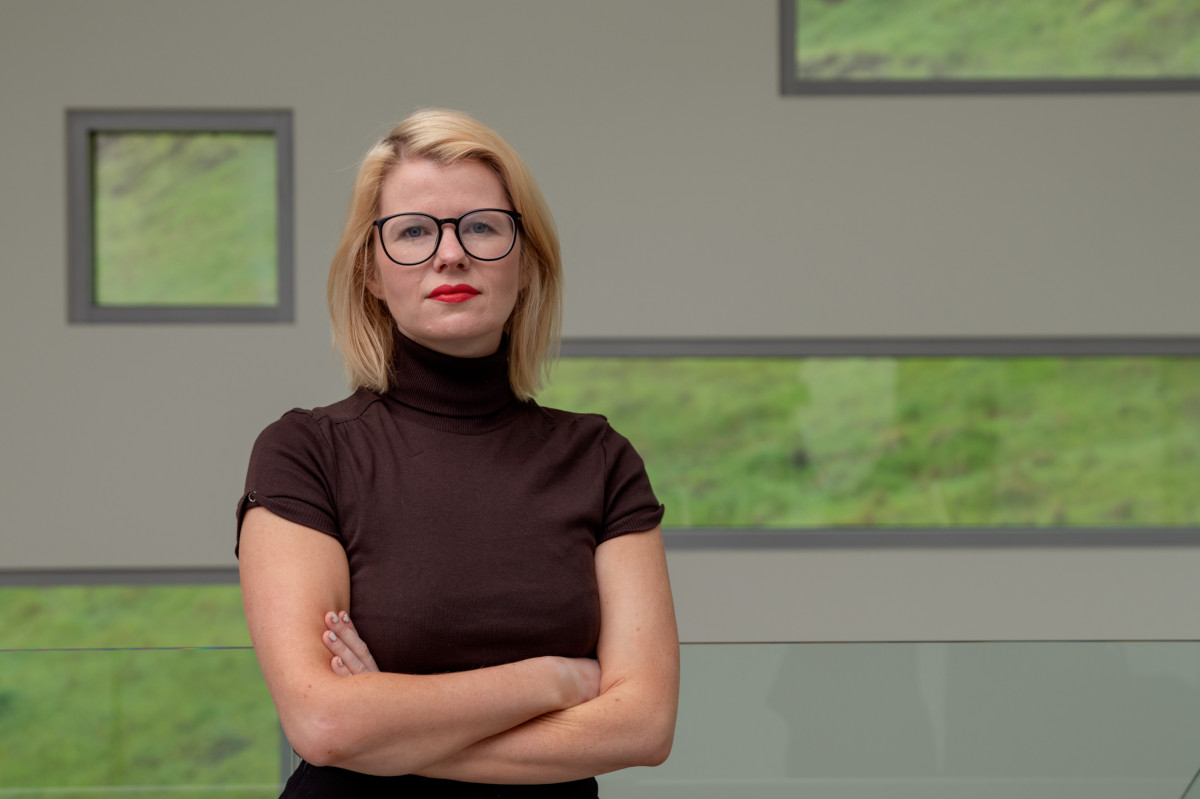
Sinead Griffin, a staff scientist in Berkeley Lab’s Materials Sciences Division and Molecular Foundry, has devoted much of her career to designing a new detector material that could help find “light” dark matter. (Credit: Thor Swift/Berkeley Lab)
Every year, during the week of Oct. 31, scientists around the world celebrate the historic hunt for dark matter – matter that is invisible to light but makes up more than 80% of the universe’s total mass. But for Sinéad Griffin, a staff scientist in Berkeley Lab’s Materials Sciences Division and Molecular Foundry, Dark Matter Day is something to celebrate every day, not just once a year.
That’s because she has devoted much of her career to designing a new detector material that could help find dark matter – akin to a tool that can detect tiny things that go bump in the night – by pinning down traces of dark matter particles known as “light dark matter.”
After earning her Ph.D. in physics in 2014 from ETH Zürich, in Switzerland, Griffin joined Berkeley Lab in 2015 as a Swiss National Science Foundation postdoctoral fellow. In 2016, she was named the Bay Area Falling Walls Young Innovator of the Year; and the next year she received the Swiss Physical Society Award for General Physics. In 2018, she won a Berkeley Lab Early Career Laboratory-Directed Research and Development award as well as first place in Berkeley Lab’s inaugural Lab-Wide Research Slam for her talk, titled “Dark Matters.”
In addition to her work on advanced materials, Griffin has mentored aspiring young scientists through Berkeley Lab’s Workforce Development & Education internship programs. And since 2010, she has lectured throughout Africa as part of the African School on Electronic Structure: Theory and Applications (ASESMA), which aims to introduce African researchers and students to the theory of electronic structure. And to promote collaboration between the U.S. and Africa, she recently co-founded the U.S.-Africa Initiative, which was awarded an inaugural American Physical Society Innovation Fund.
In this Q&A, Griffin shares her thoughts on her search for light dark matter, the ultimate materials design challenge, and Berkeley Lab’s collaborative “team science” culture.
Q: What kind of research do you do at Berkeley Lab?
Griffin: I do quantum materials theory, which is trying to figure out why materials behave the way they do, and to get them to do interesting things.
I work with theory and simulations at Berkeley Lab – so rather than performing experiments in a physical lab, we think about what we can do to a material, or what we can do to a structure, that we can simulate really accurately on the computer. There’s a lot of experiments we can perform on the computer faster and more efficiently than in a lab.
A lot of what we do is in collaboration with experimentalists. They see something odd and say, “Can you help us understand this?”
We also try to inspire new experiments. For example, I recently co-wrote a review article with a section called “From Dream to Reality.” And the idea behind this was, “Can we cook up in our imagination a material with a particular fancy property – like detecting dark matter, or a highly efficient solar cell, or in this case a ferroelectric? If we have something in our mind that we want to design into a material, how do we do this? And what are the methods and tools in doing that?”
Q: As a quantum materials scientist, what got you interested in dark matter?
Griffin: I did my master’s in quantum field theory at the Imperial College London, and Tom Kibble [a physicist at the Imperial College London who helped discover the Higgs boson] was one of the senior faculty there. He had done some work on using solid-state material systems to test high-energy physics theories, such as the so-called “Kibble-Zurek” mechanism that describes how defects form in the early universe.
I had some great conversations with him when I was a student there, and that was why I decided to do my Ph.D. in a materials theory group at UC Santa Barbara. He helped me realize that I can answer high-energy-physics-type questions – fundamental questions about the nature of the universe, “Why are we here?” kinds of questions – but with a solid-state system, or an actual real-world material.
When I was at UC Santa Barbara, I had just completed a project on superconductivity – something completely different. And it turned out that there was a visiting professor who was sharing an office with me. And he showed me some really nice images of a multiferroic material called a hexagonal manganite, but to me they looked like the types of cosmic strings [of the early universe] that Kibble had predicted.
That led me to the idea that early universe physics could actually be simulated in real materials – and that ended up taking over my Ph.D. thesis.
Through that work, I was the first to test and verify the Kibble-Zurek mechanism theory – which is a well-known theory that predicts the phase transitions of the early universe – in a crystal material.
Kibble has since passed away, but I had an opportunity to show him the results of my study at a conference toward the end of my Ph.D. program. It was pretty nice to hear him say, “Very nice. No one has done this before.”
Q: What is light dark matter, and how can it help scientists find evidence of dark matter?
Griffin: We know from different observations of the universe that dark matter is probably there and that it has mass. The problem is we only know of the total mass of dark matter but we don’t know how big the individual chunks – the particles – are. An individual particle of dark matter could be really huge, like the size of a black hole, or it could be 10 times smaller than an electron – but we don’t know how big it is or what it’s made of.
Trying to find something that’s big is much easier than trying to find something that’s small. And the way that existing dark matter searches work is that scientists have a big container made of a material, and dark matter flies in and hits off one of the atoms in the material. And then they try to measure if the atoms in the material have been moving in response to being hit by the dark matter. But we still don’t know how big individual particles of dark matter are, and we are still searching for dark matter. So that leads us to believe that it’s probably not a very large particle because we probably would have found it already.
So the idea behind light dark matter experiments is to start thinking, “Well, if dark matter was lighter, how would it start interacting with materials?” Because a light dark matter particle hitting against an atom is like a marble hitting a giant boulder – it’s not going to move the atom or the boulder.
And quantum materials are key to the search for light dark matter because we need to think of new materials with ”quasiparticles” – things that act like particles – that are not too heavy, so they will respond to very light interactions with light dark matter particles.
A lot of the quantum materials theory work that I do is for particular applications like quantum computing or microelectronics, and we already know what the solution looks like in those cases.
But the search for dark matter is the ultimate materials design challenge, because we don’t know anything about dark matter. We’re trying to come up with all different combinations of materials that would be able to test for different theories of what dark matter is.
Q: What advice would you give an early career researcher who is trying to decide between a career in industry or at a national lab?
Griffin: Ask yourself, “What gets you up in the morning? What is the thing that will keep you motivated and keep you satisfied and challenged?” For me, doing pure research is my idea of what I want to do with my life. I want to ask big questions and solve problems that no one has thought of before.
Also, consider what kind of environment you would want to work in. I think that being a scientist at a national lab like Berkeley Lab gives me a unique opportunity to work with the smartest and most creative people to solve the biggest science questions – and my interactions with other scientists is a big part of why I enjoy what I do.
The Molecular Foundry is a DOE Office of Science user facility located at Berkeley Lab.
More:
- VIDEO: “The Unsolved Mystery of Dark Matter,” Oct. 19, 2020.
- VIDEO: “Dark Matter Day Q&A with LUX-ZEPLIN Spokesperson Kevin Lesko,” Oct. 26, 2020
###
Founded in 1931 on the belief that the biggest scientific challenges are best addressed by teams, Lawrence Berkeley National Laboratory and its scientists have been recognized with 14 Nobel Prizes. Today, Berkeley Lab researchers develop sustainable energy and environmental solutions, create useful new materials, advance the frontiers of computing, and probe the mysteries of life, matter, and the universe. Scientists from around the world rely on the Lab’s facilities for their own discovery science. Berkeley Lab is a multiprogram national laboratory, managed by the University of California for the U.S. Department of Energy’s Office of Science.
DOE’s Office of Science is the single largest supporter of basic research in the physical sciences in the United States, and is working to address some of the most pressing challenges of our time. For more information, please visit energy.gov/science.
